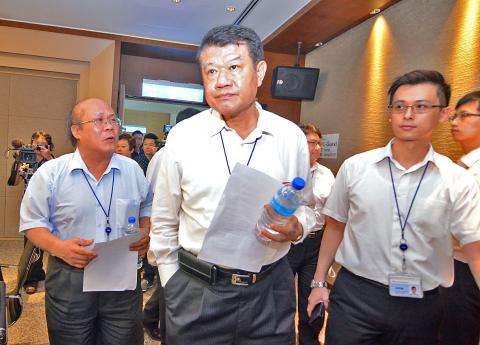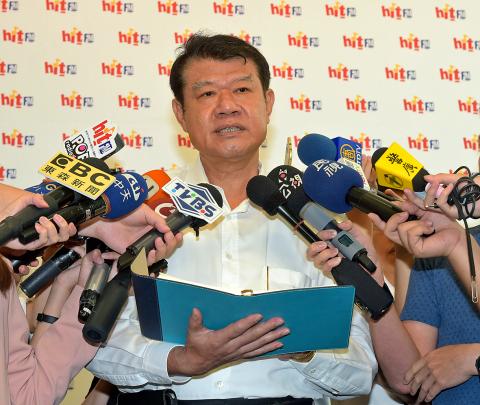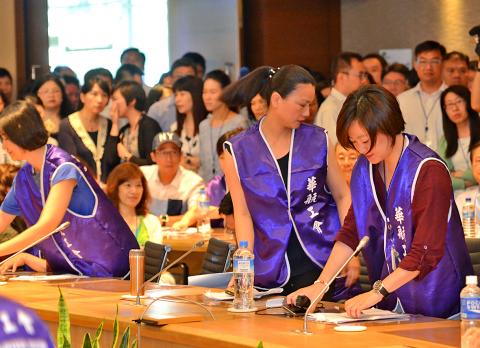The union of China Airlines (CAL, 中華航空), the nation’s largest airline company, yesterday announced that its members would “go on leave” on Friday after talks with management earlier in the day failed to reach a conclusion.
That could mean the airline is hit by a another strike, this time at the start of the summer travel season, after similar action by CAL flight attendants paralyzed most of the airline’s flights on Friday and Saturday.
Members of the China Airlines Employees Union, which covers ground staff, pilots, maintenance workers and other China Airlines employees, are seeking some of the same benefits won by the Taoyuan Flight Attendants Union on Friday.

Photo: CNA
The China Airlines Employees Union demands that the airline restore the long-frozen annual seniority-based raises and backpay accrued during the seniority freeze.
It also demands that the commuting hours of all CAL employees be included in the calculation of their work hours, that the travel allowance for all pilots and cabin crew members be raised to US$5 per hour, that the subsidy for ground staff members be increased, and that their number of annual holidays be increased from 118 to 123 days.
Other requests include increasing benefits and other remuneration for hourly-paid workers, increasing the subsidy for professional certificates and providing lodging and transportation to employees assigned to work in a foreign country, while maintaining their subsidies.

Photo: Huang Yao-cheng, Taipei Times
The China Airlines Employees Union’s first round of negotiations with new CAL chairman Ho Nuan-hsuan (何煖軒) yesterday appeared to have gone badly, with the talks beginning at 10am and ending at 3:30pm, with three breaks called to calm participants, which did not seem to have the desired effect.
Before the negotiations began, union representatives took offense at Ho’s tardiness and responded by pounding the table when he appeared 15 minutes late.
Following hours of heated exchanges, the first round of negotiations closed without reaching consensus on any of the eight union demands.

Photo CNA
The negotiations broke down after Ho asked the union to allow him to respond to the requests in two weeks’ time, which was rejected.
Ho, who assumed the post on Thursday last week, said he had not seen the demands before yesterday, and as a result could not “give yes or no answers to them at the present time.”
“Some of these demands are essay questions instead of yes or no questions, which makes it impossible for me to say yes or no on the spot,” he said.
Union representatives said that they had forwarded their list of demands last week, to which Ho said he would have preferred “a final list, not a rough one. I cannot be expected to respond or discuss a rough [draft] list.”
A union representative asked why Ho was able to respond to the demands of the Taoyuan Flight Attendants Union within three or four days’ time without consulting the balance sheets.
Ho said he had received information about the flight attendants’ strike prior to taking office, and that estimates of the costs had been calculated beforehand.
CAL was founded with government funds in 1959 and the Ministry of Transportation and Communications remains a major shareholder.
Separately yesterday, the Employees’ Union of Mandarin Airlines, (華信航空) CAL’s subsidiary, also threatened to strike if the company fails to answer its demand for the same wages and subsidies for its flight attendants as those received by CAL flight attendants.

LONG FLIGHT: The jets would be flown by US pilots, with Taiwanese copilots in the two-seat F-16D variant to help familiarize them with the aircraft, the source said The US is expected to fly 10 Lockheed Martin F-16C/D Block 70/72 jets to Taiwan over the coming months to fulfill a long-awaited order of 66 aircraft, a defense official said yesterday. Word that the first batch of the jets would be delivered soon was welcome news to Taiwan, which has become concerned about delays in the delivery of US arms amid rising military tensions with China. Speaking on condition of anonymity, the official said the initial tranche of the nation’s F-16s are rolling off assembly lines in the US and would be flown under their own power to Taiwan by way

OBJECTS AT SEA: Satellites with synthetic-aperture radar could aid in the detection of small Chinese boats attempting to illegally enter Taiwan, the space agency head said Taiwan aims to send the nation’s first low Earth orbit (LEO) satellite into space in 2027, while the first Formosat-8 and Formosat-9 spacecraft are to be launched in October and 2028 respectively, the National Science and Technology Council said yesterday. The council laid out its space development plan in a report reviewed by members of the legislature’s Education and Culture Committee. Six LEO satellites would be produced in the initial phase, with the first one, the B5G-1A, scheduled to be launched in 2027, the council said in the report. Regarding the second satellite, the B5G-1B, the government plans to work with private contractors

MISSION: The Indo-Pacific region is ‘the priority theater,’ where the task of deterrence extends across the entire region, including Taiwan, the US Pacific Fleet commander said The US Navy’s “mission of deterrence” in the Indo-Pacific theater applies to Taiwan, Pacific Fleet Commander Admiral Stephen Koehler told the South China Sea Conference on Tuesday. The conference, organized by the Center for Strategic and International Studies (CSIS), is an international platform for senior officials and experts from countries with security interests in the region. “The Pacific Fleet’s mission is to deter aggression across the Western Pacific, together with our allies and partners, and to prevail in combat if necessary, Koehler said in the event’s keynote speech. “That mission of deterrence applies regionwide — including the South China Sea and Taiwan,” he

‘NARWHAL’: The indigenous submarine completed its harbor acceptance test recently and is now under heavy guard as it undergoes tests in open waters, a source said The Hai Kun (海鯤), the nation’s first indigenous defense submarine, yesterday began sea trials, sailing out of the Port of Kaohsiung, a military source said. Also known as the “Narwhal,” the vessel departed from CSBC Corp, Taiwan’s (台灣國際造船) shipyard at about 8am, where it had been docked. More than 10 technicians and military personnel were on deck, with several others standing atop the sail. After recently completing its harbor acceptance test, the vessel has started a series of sea-based trials, including tests of its propulsion and navigational systems, while partially surfaced, the source said. The Hai Kun underwent tests in the port from